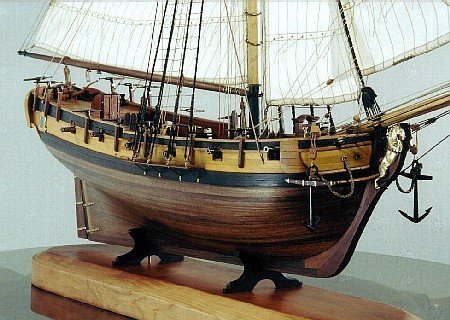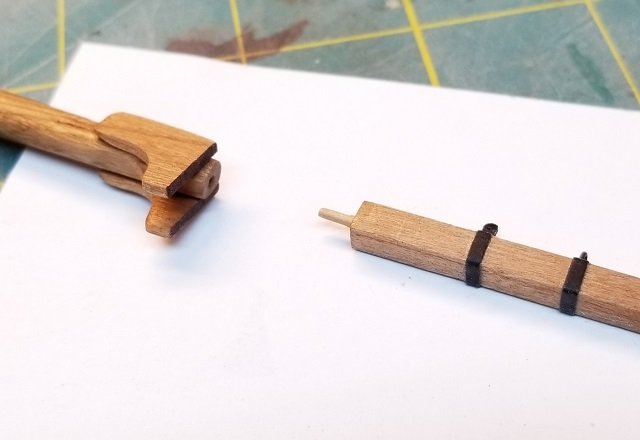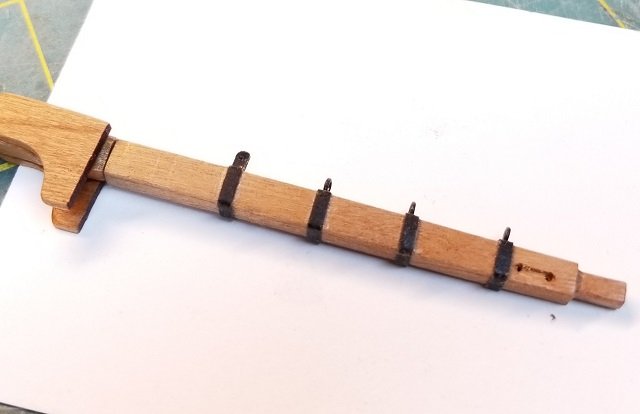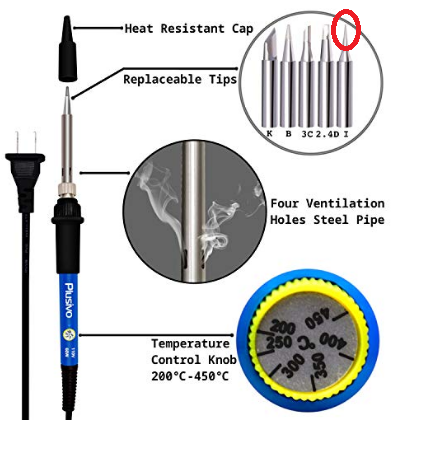-
Posts
3,143 -
Joined
-
Last visited
Content Type
Profiles
Forums
Gallery
Events
Everything posted by Gregory
-
Formula for the thickness of rope on any scale ship
Gregory replied to flying_dutchman2's topic in Masting, rigging and sails
Mondfeldt says that the thickness (diameter ) of the mainstay shall be .166% of the diameter of the main mast at the deck . ( which deck? ) The percentages in the tables are a percentage of the mainstay as measured. So if the diameter of the main mast at the deck is 2'6" ( 30" ) then the main stay should be .166 x 30 = 4.98 ". The bowsprit gammoning should be 40% of this = .40 x 4.98 = 1.992 ", and so on. Obviously you can't proceed without the main mast measurement, and the confidence that it is correct. Someone else would have to establish if Mondfeld has a reliable basis for making these claims. I think someone could give this a go on a few ropes and see if it looks good as discussed above.. -
Formula for the thickness of rope on any scale ship
Gregory replied to flying_dutchman2's topic in Masting, rigging and sails
@shipman You are a far braver man than I am, but I guess I am exposing myself to unpopularity as well; but how bad can it get? I am fully with you when it comes to " how it looks ".. " Establishments " were established so that government contracts would have a basis for going forward, and being audited at a later time. Civilian contractors would also need to meet similar requirements. They didn't want to be billed for 2 inch cable when half inch cable would have got the job done.. The size of the rope depends on the job being done, and in many respects is intuitive; this applies to the blocks as well, however, the size of the rope will determine the size of the block.. I may be oversimplifying, but maybe someone else will have more to say. I think if the builders here take a good look at the models; good ones and bad ones, they will get a good sense of what looks right.. -
Formula for the thickness of rope on any scale ship
Gregory replied to flying_dutchman2's topic in Masting, rigging and sails
I'll have to look at my Mondfeldt later, but meanwhile here is something that may help. At a scale of 1:37.5 your scale rope will be easier to determine than some smaller scales. Most of the tables you find will be in inches rather than metric, so you may find yourself with another level of conversion, however, to determine the size ( diameter ) of the scale line I am working with I wrap the line around a dowel of about 8mm diameter for 10 turns. The diameter of the dowel doesn't matter in this case . Make sure the 10 turns are touching but not compressed. I then measure the length created by the 10 turns. You then dive the distance by ten, and you will have the diameter of your scale line. Example: 10 Turns of your scale line = 8.5mm. Divide by 10 = .85mm. The diameter of your line is .85mm = approx. .03 inches. Obviously, if you are using very small line, like for ratlines and lanyards, you may want to use 15 or twenty turns and divide by the appropriate number.. I use a calculator like this: Length calculator , for my conversions.. Depending on your resources, getting scale rope in the exact size you need may be a challenge. You will have more control if you are making your own rope, but it will still take a lot trial and error to get the sizes you are satisfied with. -
That looks like it is what you want! For application, depending on the surface, I keep it in a plastic squeeze bottle and put a little directly on the surface and spread it around with a soft cloth, eventually wiping off all the excess. For smaller parts, and stuff like masts and spars, I will brush it on and let it sit a few minutes before wiping off.
-
Dutch yacht by henry x - RESTORATION
Gregory replied to henry x's topic in - Build logs for subjects built 1501 - 1750
Some models are good examples of how people can turn lousy kits into beautiful objects.. ( Eye of the beholder, and all that...) You could spend all day for the next ten years pointing out the shortcomings in thousands of build logs. I don't think that is what we are here for. It's not very becoming to come into someone's log and lecture them about the futility of their efforts based on your superior knowledge. I'm looking forward to the piece of art that Henry makes out of this salvaged model.. It has been really interesting so far. Perhaps a moderator can tidy up the log and get it back to the excellent subject it is.. -
Dutch yacht by henry x - RESTORATION
Gregory replied to henry x's topic in - Build logs for subjects built 1501 - 1750
Why? Forgive if I sound contentious, just continuing the discussion; but the worse that can happen is you have to re-glue, and it may have been a weak joint in need of strengthening.. -
I wouldn't worry about getting a perfect match beyond having the two pieces in a straight line. I assume there are going to be some trestle trees or other fittings covering up or hiding most of the joint. If you can, use a small wood dowel instead of the brass rod.. This will give you some play while setting up and a better joint when the glue dries. The seam does not have to be perfect or invisible. Once you build up the rest of the mast and add rigging it will not show. You can also do some fine tuning of the appearance after the glue dries. I often use this method to build up a mast from smaller pieces. Here is a mast I am working on but haven't glued yet.. The joint will not be visible when I am done. I hope this is what you are referring to.. If not will try to clarify.. Gregory
-
Dutch yacht by henry x - RESTORATION
Gregory replied to henry x's topic in - Build logs for subjects built 1501 - 1750
When I suggested stripper, it would be for small painted areas, with a lot of testing; say on an out of sight area, and definitely avoid glue joints. Paint thinner and even water, if left to soak, might compromise glue joints. -
Dutch yacht by henry x - RESTORATION
Gregory replied to henry x's topic in - Build logs for subjects built 1501 - 1750
Clean up is looking good. Take your time. You might consider using some paint stripper. Just make sure there is wood under the paint. Use sparingly and maybe several light applications instead of a heavy one that sits for while.. -
You may have to hand-make the shackles with wire and such, but Syren may have some blocks that would work.. There are several sizes of these types of blocks.. Internally Strapped There are several build logs where members are making detailed metal work.. Here is a good place to start.. Build logs for subjects built 1901 - Present Day Meanwhile I will be looking for some links for you.. Cornwall Model Boats has a lot of these types of fittings, but searching for them may take some maneuvering. Here is my search for shackles But other words might produce results for other fittings..
-
Dutch yacht by henry x - RESTORATION
Gregory replied to henry x's topic in - Build logs for subjects built 1501 - 1750
You might browse some of the other restorations to get ideas about cleaning techniques. Remove as many loose parts as you can and clean them individually. A mild soap solution is always a good start. Alcohol and q-tips are another option. For loosening old glue, you might try a hair dryer after you are sure there are no loose parts to go flying away. -
Dutch yacht by henry x - RESTORATION
Gregory replied to henry x's topic in - Build logs for subjects built 1501 - 1750
I would remove it just to see if there is some hidden treasure inside..🙂 I would enjoy seeing updates as you restore this.. It looks like a nice decorator model with an antique look .. -
HM Cutter Alert 1777 by muratx - scale 1:48
Gregory replied to muratx's topic in - Build logs for subjects built 1751 - 1800
Chris, Did you overlook this? -
Le Coureur by PC52 - Mamoli - 1:54
Gregory replied to PC52's topic in - Kit build logs for subjects built from 1751 - 1800
Here is an image where walrusguy ( skip down past the ship's boat ) used tissue paper to make hammocks.. Just roll up tissue paper. Wetting it may help to get a wrinkle effect.. You might use some light coloring if you don't wan't it to look too bright white.. -
There has been some talk about this.. Model Shipways USS Constitution Cross section
-
I really like the way you have several pin vise' for different bits.. I thought I was the only one who did that..
- 778 replies
-
- cheerful
- Syren Ship Model Company
-
(and 1 more)
Tagged with:
-
I really like this little Kit Soldering Iron Kit I t comes with a lot of stuff I am not likely to use, but the price is good. What is great is that it has a variable temp control .. I use the little pointed tip to melt down polyester thread nibs when tying knots.. You can make them invisible..
-
Hang in over there.. The 1949 caught my attention.. I was born Jan 15 1949 in Hearne, Tx near Bryan/College station. I see by the Farmers Almanac, the temp on that day was 75.. Then on Jan 31 it was -2.9... Brrr. We lived out in the country, so I don't think we had electricity, and pretty sure we didn't have internet..😁
- 778 replies
-
- cheerful
- Syren Ship Model Company
-
(and 1 more)
Tagged with:
About us
Modelshipworld - Advancing Ship Modeling through Research
SSL Secured
Your security is important for us so this Website is SSL-Secured
NRG Mailing Address
Nautical Research Guild
237 South Lincoln Street
Westmont IL, 60559-1917
Model Ship World ® and the MSW logo are Registered Trademarks, and belong to the Nautical Research Guild (United States Patent and Trademark Office: No. 6,929,264 & No. 6,929,274, registered Dec. 20, 2022)
Helpful Links
About the NRG
If you enjoy building ship models that are historically accurate as well as beautiful, then The Nautical Research Guild (NRG) is just right for you.
The Guild is a non-profit educational organization whose mission is to “Advance Ship Modeling Through Research”. We provide support to our members in their efforts to raise the quality of their model ships.
The Nautical Research Guild has published our world-renowned quarterly magazine, The Nautical Research Journal, since 1955. The pages of the Journal are full of articles by accomplished ship modelers who show you how they create those exquisite details on their models, and by maritime historians who show you the correct details to build. The Journal is available in both print and digital editions. Go to the NRG web site (www.thenrg.org) to download a complimentary digital copy of the Journal. The NRG also publishes plan sets, books and compilations of back issues of the Journal and the former Ships in Scale and Model Ship Builder magazines.







